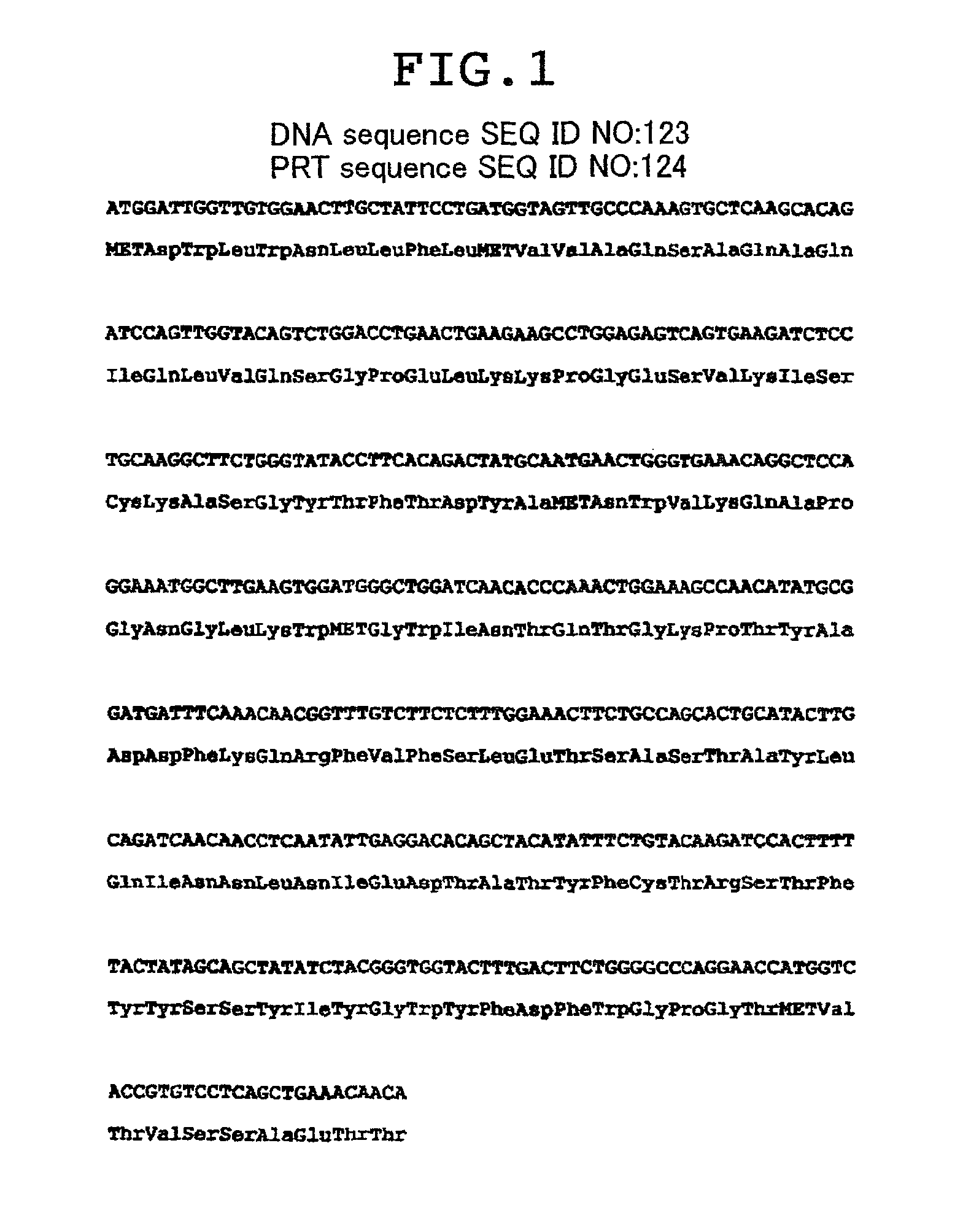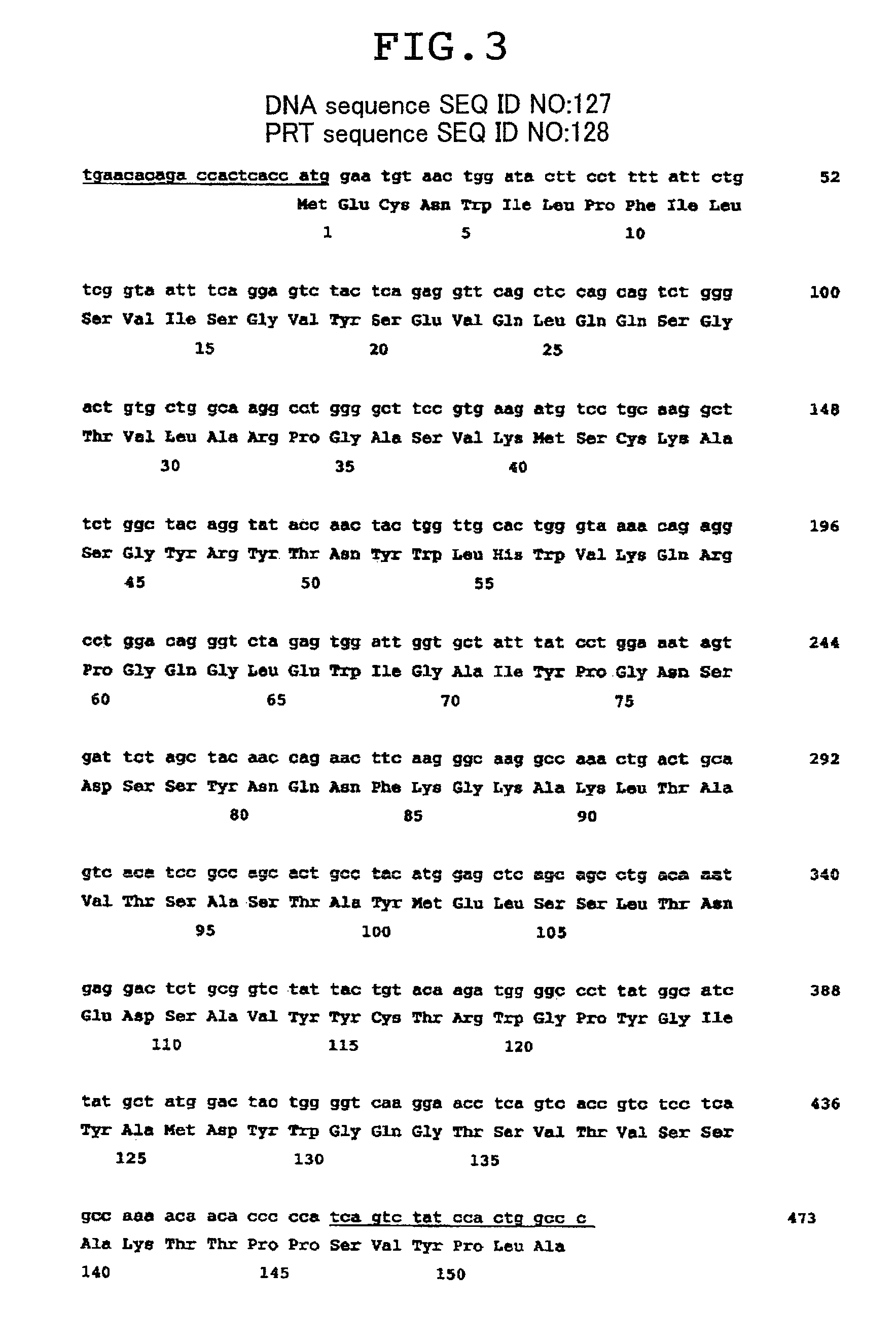Anti-CD14 antibody fusion protein
a technology of fusion protein and anti-cd14, which is applied in the field of new proteins, can solve the problems of not being used in the field of agents, cannot cope with other than gram-negative bacteria, and the pathology is worsening, and achieves the effects of anticoagulant action, anti-inflammatory action, and/or elastase inhibitory action
- Summary
- Abstract
- Description
- Claims
- Application Information
AI Technical Summary
Benefits of technology
Problems solved by technology
Method used
Image
Examples
example 1
Construction of Chimeric Antibody and Antibody Fusion Protein
[0203]1-1) Construction of Chimeric Antibody and Antibody Fusion Protein (F1024)
[0204](1) Materials
[0205]Major materials and apparatus used were as described below.
[0206]Primer: primers shown in Table 1 (synthesized by Sigma Genosys Japan, K.K.),
[0207]Enzyme for PCR: Ex Taq (TAKARA BIO INC.),
[0208]Restriction enzymes: EcoRI, BamHI, NotI, NheI, EcoRV, StuI, BglII, and others (TAKARA BIO INC.),
[0209]Genomic DNA: HeLa genome (lot. N34707-1, BD Biosciences Clontech),
[0210]PCR apparatus: DNA Engine (MJ RESEARCH, INC.),
[0211]Agarose electrophoresis gel: SeaKem GTG Agarose (TAKARA BIO INC.),
[0212]50×TAE (2 mol / L Tris-acetate, 0.05 mol / L EDTA) (NIPPON GENE CO., LTD.),
[0213]Molecular weight marker (λ DNA fragment digested with StyI),
[0214]Kit used for extraction of DNA fragment from the gel (QIAEX II, QIAGEN K.K.),
[0215]Expression vector for mammalian cell: pEF2cew (a vector produced by improving pEF-BOS), Plasmid comprising human ...
example 2
Mass Production of Antibody Fusion Protein
[0301](1) Mass Production of F1024S-D2(3) and F1031-13S-D2(3)
[0302]In order to conduct the mass production of F1024S-D2(3), transient expression system using COS-1 cell was employed. More specifically, 1700 mL of DMEM containing 10% inactivated FBS and 10 mM HEPES (pH 7.0 to 7.6) was added to CellsTACK-10 Chamber (Corning), and 21×106 COS-1 cells were inoculated in this medium. The interior of the CellsTACK-10 Chamber was replaced with a gas mixture containing 5% CO2, and after sealing the container, the medium was incubated at 37° C.
[0303]Transfection was conducted 4 days after the inoculation by the following procedure.
[0304]First, 2.12 mL of FuGENE6 transfection reagent (Rosch Diagnostics K.K.) was added to 63.6 mL of DMEM, and stirred. After 5 minutes, 530 μg each of the plasmid pTK2370 coding for the heavy chain and the plasmid pTK2344 coding for the light chain prepared in Example 1 were added, and after stirring, the culture was allow...
example 3
Evaluation of Efficacy (In Vitro)
[0317]3-1) Confirmation of Antibody Activity
[0318](1) Confirmation of Inhibitory Activity for LPS-Induced IL-6 Production in Human Vascular Endothelial Cell
[0319]Endothelial cells of the human umbilical cord vein (HUVEC, Sanko Junyaku Co., Ltd.) separated by PBS(−) containing 0.05% trypsin and 0.02% EDTA were suspended in RPMI 1640 medium (SIGMA) containing 10% of human serum (TENNESSEE BLOOD SERVICE CORPORATION), and inoculated in 96-well plate at 2×104 cells / well. The cells were incubated overnight at 37° C. in the presence of 5% CO2. After the incubation, LPS (WE. coli 055:B5, DIFCO) was added to a final concentration of 10 ng / mL, and simultaneously, F1024S-D2(3) was added to final concentrations of 0.03, 0.1, 0.3, 1, 3, and 10 μg / mL. After incubating at 37° C. in the presence of 5% CO2 for 6 hours, the IL-6 in the culture supernatant was measured by using human IL-6 EIA kit (Diaclone Research) according to the attached protocol. IC50 value for th...
PUM
| Property | Measurement | Unit |
|---|---|---|
| distance | aaaaa | aaaaa |
| concentration | aaaaa | aaaaa |
| pH | aaaaa | aaaaa |
Abstract
Description
Claims
Application Information
 Login to View More
Login to View More - R&D
- Intellectual Property
- Life Sciences
- Materials
- Tech Scout
- Unparalleled Data Quality
- Higher Quality Content
- 60% Fewer Hallucinations
Browse by: Latest US Patents, China's latest patents, Technical Efficacy Thesaurus, Application Domain, Technology Topic, Popular Technical Reports.
© 2025 PatSnap. All rights reserved.Legal|Privacy policy|Modern Slavery Act Transparency Statement|Sitemap|About US| Contact US: help@patsnap.com



